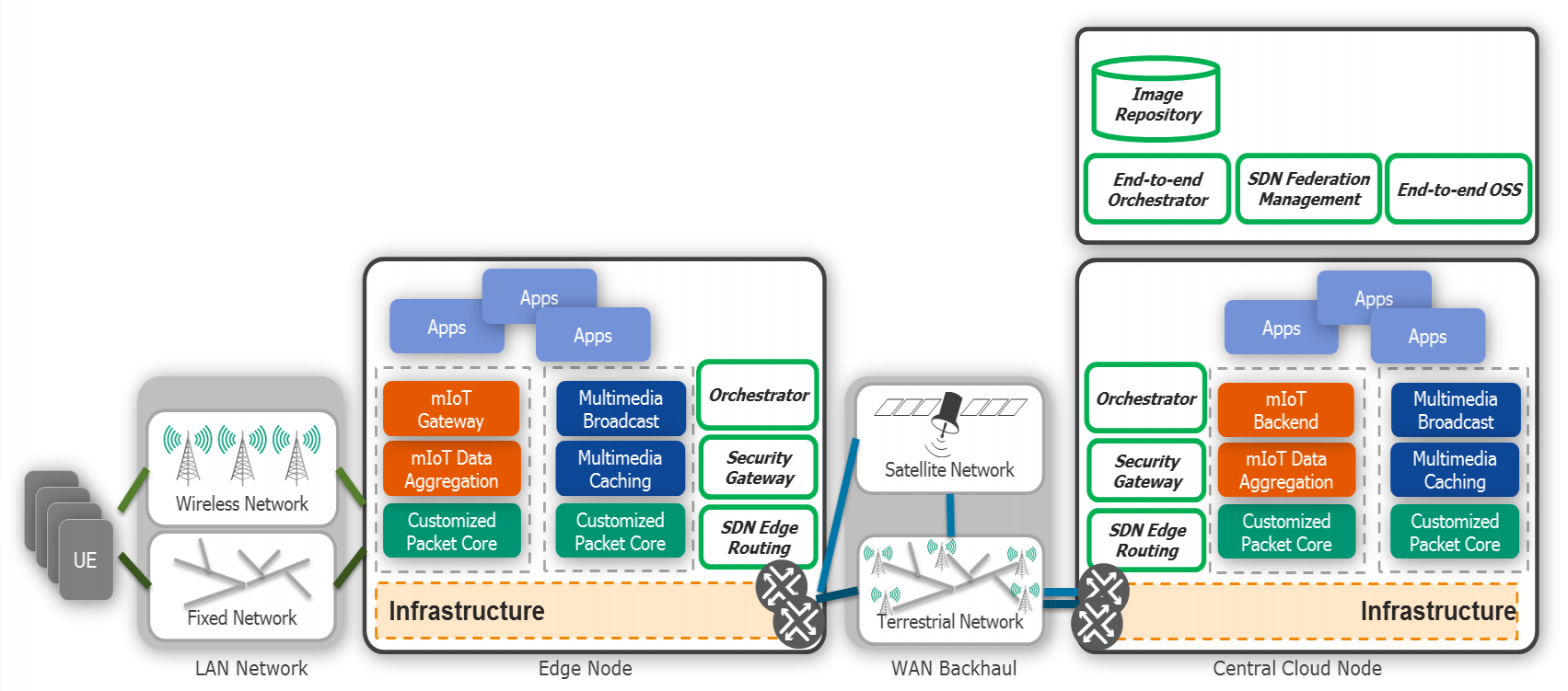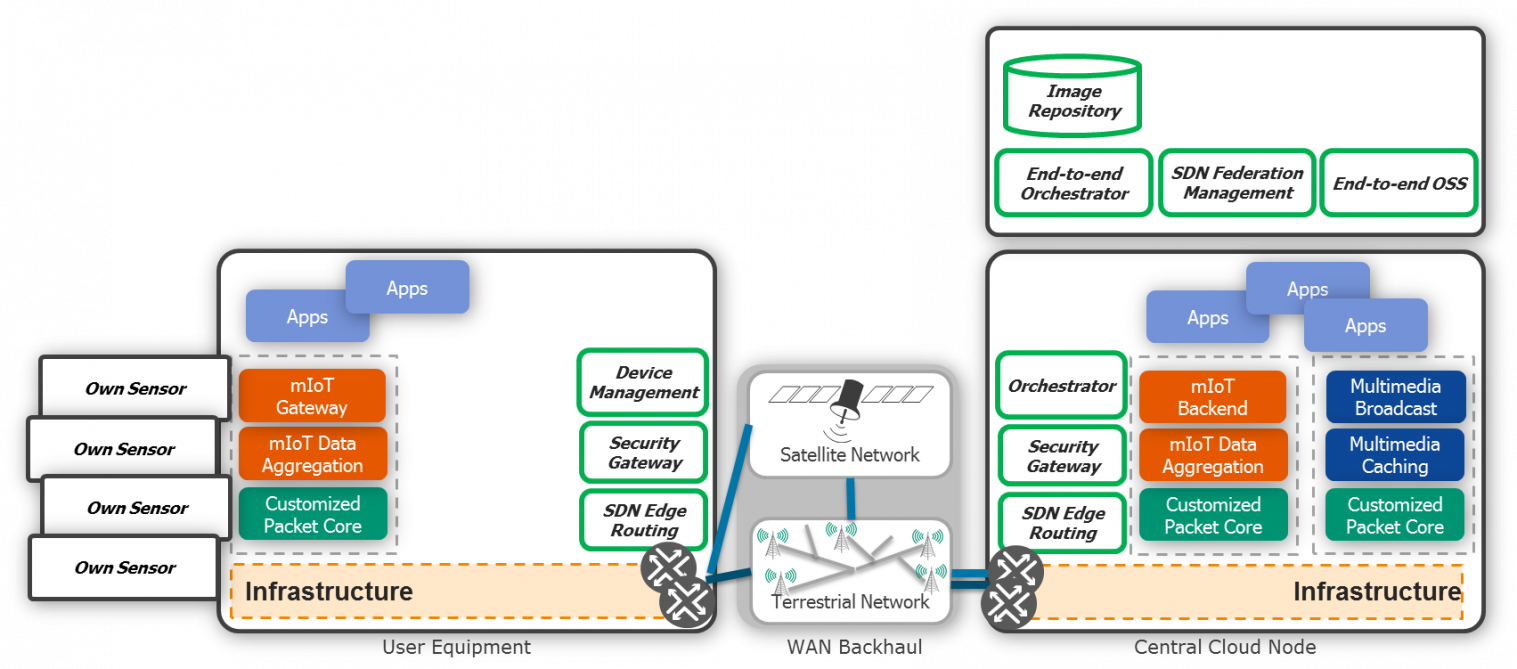
-
StatusCompleted
-
Status date2023-04-11
-
Activity Code3A.075
SATis5
-
Provides a comprehensive testbed showcasing major technology progress and demonstrating the benefits of satellite technology for the main 5G use cases. The testbed includes live, over the air GEO and MEO satellite connectivity in addition to laboratory emulations and simulations and uses a federation of terrestrial locations. The testbed is an open federation of resources that can incorporate additional locations in the future for addressing new deployment situations and use cases;
-
Highlights the advantages of satellite technology in a range of situations and thus feeds into a roadmap and vision, and supports satellite stakeholders to position themselves in the 5G context;
-
Creates a very substantial impact on the telecommunications industry going beyond the satellite industry. The activity is instrumental and drives the full integration of satellite in 5G through open and standard solutions, facilitated primarily through 3GPP standardization.
The main challenge addressed in the SATis5 project is the satellite-terrestrial network integration within the 5G ecosystem.
The activity tackles the following major technical challenges concerning the various technology enablers:
-
Distribution of orchestration across the specific communication environment;
-
Distribution of the control plane across the specific communication environment;
-
Slice Management and Service Function Chain Orchestration through the integration with NFV-MANO;
-
Security enforcement and isolation of the multiple slices;
-
Reduction of state management for flexible elasticity and migration;
-
VNF-programmability and customisation to address the specific needs of the applications;
-
End-to-end management and interworking across multiple carriers including: WAN Infrastructure Manager (WIM);customer edge router (in the Access Network); provider edge router (between Access Network and Core Network); and the integration with legacy and 3rd party services;
-
Security-by-design: integrated security solution within the architecture, customizable to the requirements of the applications;
-
Orchestration of the edge intelligence and Multi-access Edge Computing (MEC) node, functional split and synchronisation with central nodes;
-
New Radio (NR) integration with satellite, convergent integration of existing technologies;
-
Extension of device management for network assisted slice selection in a multi-slice environment.
The demonstrator showcases for the first time in a live environment the benefits of using satellite technology in 5G enabling a better understanding of the role that satellite could have in 5G systems.
Following a modular architecture, the testbed is designed to be able to incorporate additional remote testbeds within a large-scale federation, next to the proposed four nodes, through this being able to naturally extend towards other locations.
Through the harmonisation of SatCom with 5G network features such as virtualisation, network slicing, control/user plane protocols, broadcast/multicast, SATis5 serves and enables the following new business models:
-
Reducing initial CAPEX investment to enter new markets, through very small and dynamic infrastructure deployments;
-
Opening up more backhaul and direct connectivity options in remote areas and towards highly distributed environments;
-
Secure and reliable deployments of highly distributed enterprise networks;
-
Support for on-demand network capacity increase in dense communication areas.
-
Reducing on-going OPEX costs in remote environments;
-
Delivering lower costs per subscriber by targeting small concentrated pockets of users;
-
Enabling new ecosystems where the operator no longer needs to own and run the entire RAN (Radio Access Network).
SATis5 also brings key benefits for the 5G mobile industry:
-
Profitable investment for mobile industry to deploy 5G backhaul to underserved areas;
-
Take up of 5G services in low ARPU markets much faster than previous generations;
-
Seamless accessibility for 5G vertical markets in rural and remote regions;
-
Rapid deployment of highly distributed and secure sparse enterprise networks addressing 5G verticals with global connectivity coverage requirements;
-
Rapid secure and resilient deployment for emergency scenarios;
-
Delivery of very rich multimedia video content at low cost;
-
Rapid “plug and play” new service creation potential in previously difficult geographies.
The testbed provides a full end-to-end technology integration addressing the 5G communication environment including satellite and terrestrial components. Key technologies include:
-
Distributed NFV orchestration across the environment;
-
Support for a distributed, edge oriented 5G control plane across the environment;
-
Diverse, dynamic data path support with local offload, multicast and efficient small messages distribution;
-
Extension of device management for slice-selection;
-
Support for a secure and isolated multi-slice environment using service function chaining extensions;
-
End-to-end network management across a multi-carrier environment;
-
Slice programmability and customisation to applications;
-
Integration with legacy and 3rd party services;
-
Integration of edge intelligence and Multi-access Edge Computing (MEC) node, functional split and synchronisation with central nodes;
-
New Radio (NR) integration with satellite, convergent integration of existing technologies;
The testbed is based on a set of remote nodes that include their own communicating devices, local access network, local edge functionality and central nodes incorporating the rest of the support as well as the end-to-end network management. From the perspective of the satellite connectivity two modes are considered: backhaul connectivity for terrestrial 5G networks and direct 5G communication.
The high level system architecture concerning backhaul looks like as follows:

whilst concerning direct connectivity it is as follows:

The SATis5 project had a 24-month duration, which is complemented by an additional 12-month testbed service phase.
The testbed development consists of four major phases:
-
In the first seven months, the testbed architecture is defined and specified, and a development and validation plan is established.
-
In the following five months, a testbed design and validation plan is provided together with the initial testbed. This means that after the first year, a live testbed should be available.
-
Phase three lasts six months, and includes the customization of the testbed with key technologies.
-
The last six months are used for integration and demonstration of the new technologies.
The demonstrator remains available for an additional year as part of the testbed service phase.
The first implementation of the SATis5 testbed is completed. Two important demonstrations of integrated satellite terrestrial communication use cases have been demonstrated during the FUSECO FORUM 2018 (https://www.fokus.fraunhofer.de/ngni/events/fuseco_forum_2018#):
-
5G connectivity ‘on the move’ with a satcom-enabled van and addressing communication requirements including eHealth, rapid response and temporary deployments for public events
-
‘edge delivery’ through a stationary network extended by satellites
Both demonstrations showcased technology enablers for multi-sliced 5G Satellite enabled edge nodes, fixed and portable as the satcom-enabled van.
The deployed SATis5 testbed has been extended to support global use cases, specifically it supports joint experiments and trials with Japan, where the intercontinental distances and the large delay introduced by the use of a GEO satellite represent particular challenges. Together with a Japanese counterpart consortium supported by the National Institute of Communication Technology (NICT), Japan, SATis5 successfully tested and verified the support to both Internet-of-Things data, and high-definition broadcast quality 4K video transmission under such circumstances. Further extensions for an ultra-reliable end-to-end connectivity are currently under development.





